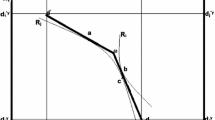Abstract
Inspired by Clower’s conjecture that the necessity of trading through money in monetised economies might hinder convergence to competitive equilibrium, and hence, for example, cause unemployment, we experimentally investigate behaviour in markets where trading has to be done through money. In order to evaluate the properties of these markets, we compare their behaviour to behaviour in markets without money, where money cannot intervene. As the trading mechanism might be a compounding factor, we investigate two kinds of market mechanism: the double auction, where bids, asks and trades take place in continuous time throughout a trading period; and the clearing house, where bids and asks are placed once in a trading period, and which are then cleared by an aggregating device. We thus have four treatments, the pairwise combinations of non-monetised/monetised trading with double auction/clearing house. We find that: convergence is faster under non-monetised trading, implying that the necessity of using money to facilitate trade hinders convergence; that monetised trading is noisier than non-monetised trading; and that the volume of trade and realised surpluses are higher with the double auction than the clearing house. As far as efficiency is concerned, monetised trading lowers both informational and allocational efficiency, and while the double auction outperforms the clearing house in terms of allocational efficiency, the clearing house is marginally better than the double auction in terms of informational efficiency when trade is through money. Crucially we confirm the conjecture that inspired these experiments: that the necessity to use money in trading hinders convergence to competitive equilibrium, lowers realised trades and surpluses, and hence may cause unemployment.




Similar content being viewed by others
Notes
We note that this is not the same as Goeree and Lindsay’s (2012b) schedule market, though it does have some features in common.
There is ‘cash’ in his markets, but this is used only for accounting purposes.
In the experiment we put n equal to 5. We deliberately made the numbers of each type the same, and made the total number of subjects in each session sufficiently high to avoid any monopolistic possibilities.
The experiment was conducted in Italy and subjects were paid in euros. There are 100 centesimi in a euro. A euro is currently worth about £0.74 or $1.13.
The notation ‘ABa,b’ indicates an experimental session using the AB trading mechanism with parameters x = a and y = b.
In a sense it is a repeated, rather than a dynamic, problem, except for the existence of—ultimately worthless—experimental money.
CEntro Sperimentale A Roma Est.
It should be noted that we chose the various endowments to make these as nearly equal across parameter sets to make it fair to the subjects.
Different sessions had different lengths and the shortest length was 18.
The p-values report the significance levels of the Wilcoxon rank-sum test, between the figures in the adjacent rows or columns.
References
Barro, R. J., & Grossman, H. I. (1971). A general disequilibrium model of income and employment. American Economic Review, 61, 82–93.
Benassy, J.-P. (1975). Neo-keynesian disequilibrium theory in a monetary economy. Review of Economic Studies, 42, 203–220.
Cason, T. N., & Friedman, D. (2008). A comparison of market institutions. In C. R. Plott & V. L. Smith (Eds.), Handbook of experimental economics results (Vol. 1, pp. 264–272). Amsterdam: Elsevier.
Clower, R. W. (1967). A reconsideration of the microfoundations of monetary theory. Economic Inquiry, 6, 1–8.
Crockett, S., Oprea, R., & Plott, C. R. (2011). Extreme walrasian dynamics: The gale example in the lab. American Economic Review, 101, 3196–3220.
Friedman, D. (1993). How trading institutions affect financial market performance: Some laboratory experiments. Economic Inquiry, 31, 410–435.
Gjerstad, S. (2013). Price dynamics in an exchange economy. Economic Theory, 52, 461–500.
Goeree, J. K. and Lindsay, L. (2012a), Designing Package Markets to Eliminate Exposure Risk, University of Zurich Working Paper 71.
Goeree, J. K. and Lindsay, L. (2012b), Stabilizing the Economy: Market Design and General Equilibrium, University of Zurich Working Paper.
Greiner, B. (2004), The Online Recruitment System ORSEE 2.0—A Guide for the Organization of Experiments in Economics. University of Cologne, Working Paper Series in Economics 10.
Hey, J. D., & Di Cagno, D. (1998). Sequential markets: An experimental investigation of Clower’s dual decision hypothesis. Experimental Economics, 1, 63–87.
Kiyotaki, N., & Wright, R. (1989). On money as a medium of exchange. Journal of Political Economy, 97, 927–954.
Leijonhufvud, A. (1968). On keynesian economics and the economics of keynes. Oxford: Oxford University Press.
Lucas, R. E, Jr. (1980). Equilibrium in a pure monetary economy. Economic Inquiry, 18, 203–220.
Ostroy, J. M., & Starr, R. M. (1974). Money and the decentralization of exchange. Econometrica, 42, 1093–1113.
Shapley, L., & Shubik, M. (1977). Trade using one commodity as a means of payment. Journal of Political Economy, 85, 937–968.
Acknowledgments
The authors would like to express their gratitude to Andrea Lombardo for writing the software in Visual Studio for these experiments. We also thank LUISS for use of their purpose-built laboratory, run under the auspices of CESARE. Finally we would like to thank the Editor and three referees for invaluable comments which led to significant changes in the paper.
Author information
Authors and Affiliations
Corresponding author
Electronic supplementary material
Below is the link to the electronic supplementary material.
Rights and permissions
About this article
Cite this article
Hey, J.D., Di Cagno, D. Does money impede convergence?. Exp Econ 19, 595–612 (2016). https://doi.org/10.1007/s10683-015-9456-x
Received:
Revised:
Accepted:
Published:
Issue Date:
DOI: https://doi.org/10.1007/s10683-015-9456-x
Keywords
- Clearing house mechanism
- Double auction mechanism
- Experimental markets
- Money
- Monetised trading
- Non-monetised trading




